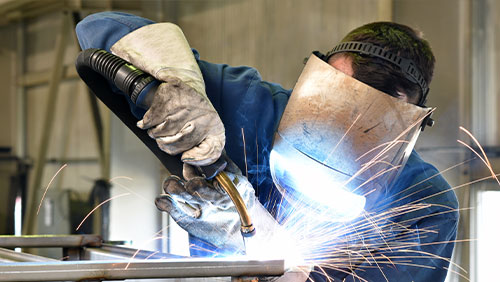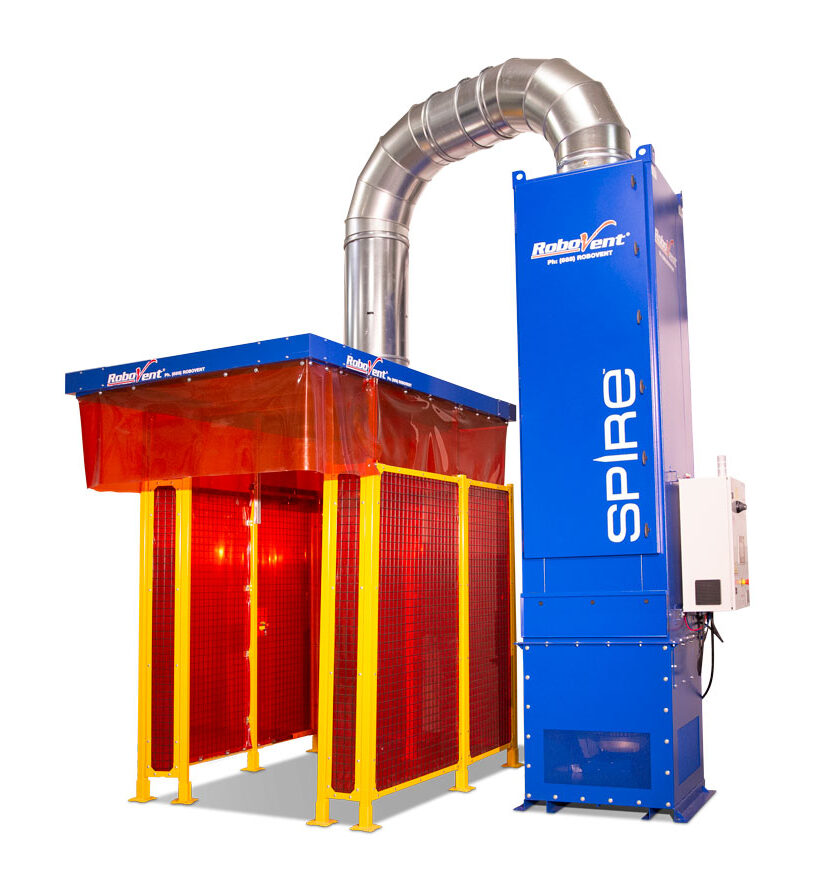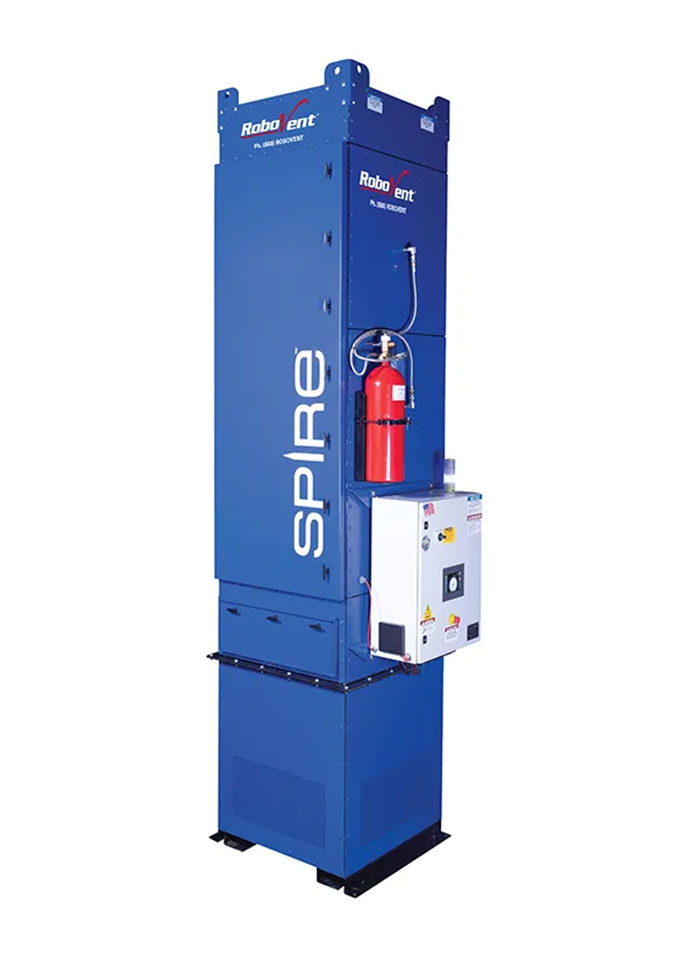Welding Health Risks and How to Address Them
 Welding safety is a critical topic for both manual and robotic welding. There are a number of occupational health & safety risks for welding, including serious health risks from weld fume exposure. Weld fume management, along with other welding safety measures, is essential to protect workers from potential occupational hazards.
Welding safety is a critical topic for both manual and robotic welding. There are a number of occupational health & safety risks for welding, including serious health risks from weld fume exposure. Weld fume management, along with other welding safety measures, is essential to protect workers from potential occupational hazards.
Download the complete guide to welding fume extraction systems.
Overview of Welding Occupational Health and Safety Risks
Welding involves the use of intense heat to join metals together and sometimes to add a filler metal to the joint. This process presents several occupational health and safety risks.
- Exposure to Harmful Fumes and Gases: Welding can produce hazardous fumes and gases that can be harmful if inhaled. These can include gases like ozone, carbon monoxide, and nitrogen oxides, as well as metal fumes containing toxic materials such as hexavalent chromium, zinc oxide, manganese, lead or aluminum. Prolonged exposure can lead to respiratory issues, metal fume fever, and even neurological damage in severe cases.
- Fire and Explosion Hazards: The sparks and spatter from welding can ignite flammable materials and gases in the vicinity, posing a significant risk of fire or explosion, especially in environments where there is an accumulation of flammable materials or gases.
- Electric Shock: Electric shock is a serious risk for welders, particularly in environments that are wet or if the welder is in contact with grounded surfaces. This can lead to severe injuries or even death.
- Radiation Exposure: Welding produces ultraviolet (UV) and infrared (IR) radiation, which can cause burns to the skin and eyes, commonly known as “arc eye” or “welder’s flash.” Prolonged exposure can also lead to an increased risk of cataracts and skin cancer.
- Physical Hazards: These include injuries from lifting, slips, trips and falls, and being struck by falling objects. The use of heavy equipment and working in potentially cramped positions can also lead to musculoskeletal injuries.
- Noise-Induced Hearing Loss: Welding operations can sometimes generate high levels of noise, which can lead to temporary or permanent hearing loss if appropriate hearing protection is not used.
- Heat Stress: Welding can be a hot work process, especially in confined spaces or during hot weather. Welders are at risk of heat stress, which can lead to heat exhaustion or heat stroke.

Health Risks of Weld Fume Exposure
Inhaling welding fumes is one of the biggest occupational risks for welders. Weld fumes contain a complex mixture of metals and metallic oxides, silicates and fluorides that can pose significant health risks to workers when inhaled. Fumes are generated when a metal is heated above its boiling point and its vapors condense into very fine particles. The specific health risks associated with weld fume exposure can vary depending on the composition of the fumes, which in turn depends on the type of metals being welded, the welding process, and the presence of any coatings on the welded materials.
Acute Respiratory Health Risks
Acute health risks involve immediate or rapid onset of symptoms after exposure to a hazard. The symptoms manifest quickly, typically within minutes to hours or a few days after exposure. While acute reactions can range from mild to severe, they are often noticeable shortly after exposure and can be directly linked to a specific event or exposure. They typically resolve once the exposure is removed, though repeated exposures can lead to long-lasting or chronic health impacts. Acute exposure risks for weld fumes include:
- Irritation of the Respiratory Tract: Inhalation of weld fumes can cause throat and lung irritation, leading to coughing and shortness of breath.
- Metal Fume Fever: Metal fume fever causes flu-like symptoms, including fever, chills, nausea, headache, fatigue, muscle aches and joint pains. It’s often caused by exposure to zinc, magnesium, aluminum and copper fumes.
- Asphyxiation: Welding in confined spaces poses a significant risk of asphyxiation due to the displacement of oxygen by inert shielding gases or the accumulation of harmful gases that can reduce the available oxygen. The use of certain welding processes can also produce combustion gases like carbon monoxide and carbon dioxide, further depleting oxygen levels and increasing the risk of asphyxiation.
Chronic Respiratory Health Risks
Repeated exposure to toxic weld fumes is correlated with a number of chronic respiratory health impacts. Chronic health risks are characterized by long-term effects that develop slowly over time, often due to repeated or continuous exposure to a hazard. Symptoms may take years to manifest, making it harder to link them directly to specific exposures. Chronic conditions can be debilitating and may lead to permanent damage or impairment. They often require long-term management or treatment. Chronic respiratory health risks for welding include:
- Asthma: Repeated exposure to certain welding fumes can lead to the development of occupational asthma, characterized by wheezing, tightness in the chest and difficulty breathing.
- Chronic Obstructive Pulmonary Disease (COPD): Long-term exposure to welding fumes can contribute to the development of COPD, a group of lung diseases that block airflow and make it difficult to breathe.
- Lung Cancer: Prolonged inhalation of certain carcinogenic substances in welding fumes, such as hexavalent chromium and nickel, increases the risk of lung cancer.
- Pneumonia: Welders are at an increased risk of developing pneumonia, which can be triggered by exposure to welding fumes. The Centers for Disease Control and Prevention (CDC) has recently recognized a new form of pneumonia in welders called Welder’s Anthrax, which is caused by an infection with bacteria in the B. cereus group in conjunction with weld fume exposure. While rare, this is a very serious form of welder’s pneumonia.
Neurological Effects
Welding can potentially cause neurological damage through exposure to certain toxic substances produced during the welding process. The most well-documented neurological effect associated with welding is a result of exposure to manganese, a metal that is often present in welding fumes, especially when welding steel and other alloys. Manganism produces neurological symptoms similar to Parkinson’s disease, including tremors, difficulty with coordination and stiff muscles. These symptoms are due to the neurotoxic effects of manganese on the dopaminergic system, which is also affected in Parkinson’s disease.
Kidney Damage
Welding fumes containing metals like cadmium, lead and chromium can cause kidney damage over time as the body struggles to filter these metals out. The body has a limited ability to remove certain metals. Over time, these metals can accumulate to toxic levels, particularly in the kidneys, which are responsible for filtering these substances from the blood. This accumulation can lead to chronic kidney disease (CKD) or acute kidney injury (AKI). Some metals found in welding fumes have direct toxic effects on kidney cells. For example, cadmium can cause damage to the renal tubules, leading to reduced kidney function and proteinuria (the presence of excess proteins in the urine), which is a sign of kidney damage.
Cancer
Weld fume exposure is associated with an increased risk of several types of cancer, primarily due to the carcinogenic compounds that can be present in the fumes produced during welding. The International Agency for Research on Cancer (IARC) has classified welding fumes as “carcinogenic to humans” (Group 1). This classification reflects the evidence linking exposure to weld fumes with an increased risk of certain cancers. Several components of welding fumes have been identified as carcinogens or potential carcinogens, including hexavalent chromium (Cr(VI) or hex chrome) (commonly found in stainless steel welding fumes), nickel, cadmium (found in many paints and coatings), beryllium and formaldehyde. Cancer risks of welding include:
- Lung Cancer: The most well-documented cancer risk from welding fume exposure is lung cancer. Welders and workers exposed to welding fumes have a higher incidence of lung cancer compared to the general population.
- Kidney Cancer: There is some evidence to suggest an increased risk of kidney cancer in welders, although the specific causal agents within welding fumes are not as well defined.
- Bladder Cancer: Some studies have suggested a potential link between welding fume exposure and an increased risk of bladder cancer, though more research is needed to confirm this association.
Other Health Risks
Weld fume exposure is associated with other health risks, as well. Some of the most common include:
- Skin and Eye Irritation: Direct contact with weld fumes can cause skin irritation and dermatitis, as well as eye irritation and damage, including conjunctivitis and UV radiation burns from the welding arc.
- Gastrointestinal Issues: Ingesting or inhaling certain metals found in welding fumes can lead to stomach ulcers and other gastrointestinal problems.
Understanding Weld Fume Exposure Risks
 The exposure risk to weld fumes can be influenced by several factors, each playing a significant role in determining the level of risk a welder or nearby worker might face. Understanding these factors is crucial for implementing effective control measures to minimize exposure and protect worker health. Several factors impact total weld fume exposure risks.
The exposure risk to weld fumes can be influenced by several factors, each playing a significant role in determining the level of risk a welder or nearby worker might face. Understanding these factors is crucial for implementing effective control measures to minimize exposure and protect worker health. Several factors impact total weld fume exposure risks.
- Welding Type (Manual vs. Robotic): In general, manual welding puts welders at higher risk for weld fume exposure and associated health impacts. This is because they are operating closer to the weld seam and may be in the direct line of the weld smoke plume. In addition, robotic welding can be typically kept under a hood or enclosure to prevent weld fumes from propagating through the facility.
- Welding Process: Different welding processes generate fumes at varying rates and compositions. In general, welding processes that use a consumable, such as MIG, stick or flux-core welding, produce more weld smoke than resistance welding or laser welding, which do not use a consumable weld wire or welding rod. The specific process used significantly impacts the quantity and toxicity of the fumes produced.
- Type of Materials Welded: The composition of the base metal and any coatings (e.g., paint, plating or rust inhibitors) can significantly influence fume composition. For example, welding stainless steel releases hexavalent chromium, a known carcinogen, while welding galvanized steel can release zinc oxides, leading to metal fume fever.
- Duration and Frequency of Exposure: Longer exposure times and frequent welding activities increase the risk of adverse health effects from weld fume inhalation. Both the intensity and duration of exposure are critical factors in determining overall risk.
- Position Relative to the Fume Plume: The welder’s position in relation to the weld smoke plume can affect exposure levels. Welding techniques and positions that place the welder’s head above the plume can result in higher inhalation of fumes.
- Ventilation and Workspace Configuration: Adequate ventilation is essential in reducing weld fume exposure. Confined spaces or poorly ventilated areas can lead to higher concentrations of weld fumes, increasing exposure risk. The effectiveness of source capture solutions, local exhaust ventilation (LEV) systems or air filtration systems in the workspace plays a critical role.
Mitigating Weld Fume Exposure
Mitigating the health impacts of weld fumes often involves a combination of engineering controls, administrative controls, and the use of personal protective equipment (PPE). The goal is to minimize exposure to hazardous substances in weld fumes. Employers are responsible for ensuring that workers are not exposed to hazardous weld fumes at levels above the Permissible Exposure Limit (PEL) set by the Occupational Health and Safety Administration (OSHA), which sets safety standards for weld fume exposure. OSHA sets PELs for total weld fume exposure as well as for individual components of weld smoke such as hexavalent chromium and manganese.
Testing Your Facility
It is important to assess the levels of weld fumes in the workplace to identify areas or processes with high exposure risks. This information can guide the implementation of targeted control measures. Facility testing may involve exposure testing for individual workers (using a wearable air sampler) and the use of air sampling equipment in various locations in the facility.
Engineering Controls for Weld Smoke
 Engineering controls such as dust collection, industrial air filtration, and ventilation are the primary defense against toxic fumes from manual or robotic welding. Engineering controls must be used before relying on personal protective equipment (PPE). Source capture, in which weld smoke is captured close to the source where it is generated, is the preferred control option wherever practical. For manual welders, fume guns, fume arms and backdraft tables are used to keep weld smoke out of the breathing zone. Robotic welders can often be fully enclosed under a hood ducted to a dust collector.
Engineering controls such as dust collection, industrial air filtration, and ventilation are the primary defense against toxic fumes from manual or robotic welding. Engineering controls must be used before relying on personal protective equipment (PPE). Source capture, in which weld smoke is captured close to the source where it is generated, is the preferred control option wherever practical. For manual welders, fume guns, fume arms and backdraft tables are used to keep weld smoke out of the breathing zone. Robotic welders can often be fully enclosed under a hood ducted to a dust collector.
See our complete lineup of weld fume extractors.
Personal Protective Equipment
When engineering and administrative controls cannot reduce fume exposure to safe levels, appropriate respirators, such as a powered air-purifying respirator (PAPR), should be provided. Respiratory PPE may be needed when welding in enclosed areas or other situations where the PEL cannot be met through engineering controls alone; it should not be a substitute for air filtration and ventilation. Welders also need PPE for skin and eye protection, including protective clothing and safety glasses or welding helmets with appropriate filter shades.
Medical Surveillance
Regular health check-ups and specific medical tests (e.g., lung function tests or blood tests) may also be part of a weld fume safety program, especially when working with highly hazardous substances. The aim of a medical surveillance program is to identify early signs of health effects related to weld fume exposure. Medical surveillance may be required when working with certain substances (such as lead or hex chrome) or if there has been an incident or complaint about exposures.
Other Administrative Controls
Other steps may also be taken to reduce weld fume exposure. Other administrative controls include:
- Training and Education: Educate workers on the hazards associated with weld fumes, the importance of using control measures, and the correct use of PPE. Training should also cover safe work practices to minimize fume exposure.
- Work Rotation: Rotate workers through different tasks to limit the duration of exposure to weld fumes and reduce the risk of overexposure to any one individual.
Protecting Workers from Hazardous Weld Fumes
Employers have a duty to create a safe and healthy working environment and protect welders from the occupational risks of welding. RoboVent works with manufacturers, fabrication shops, welding schools and others to identify the risks of weld smoke exposure and put mitigation strategies in place. We can help you protect workers and ensure compliance with OSHA and other regulations.
Talk to a solution specialist about your weld fume exposure concerns.
Contact Us With Your Questions!
SUBSCRIBE TO
BLOG UPDATES









